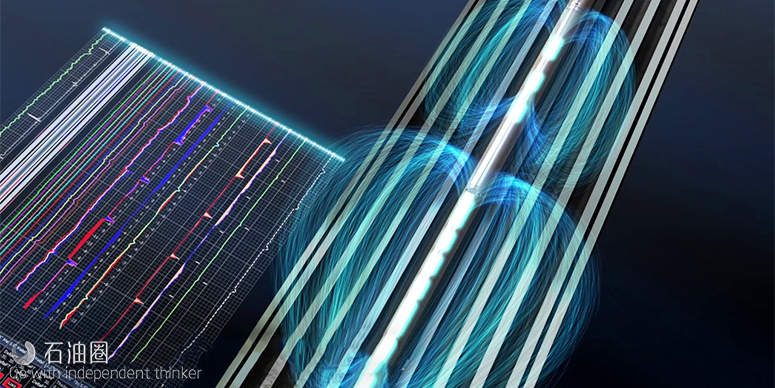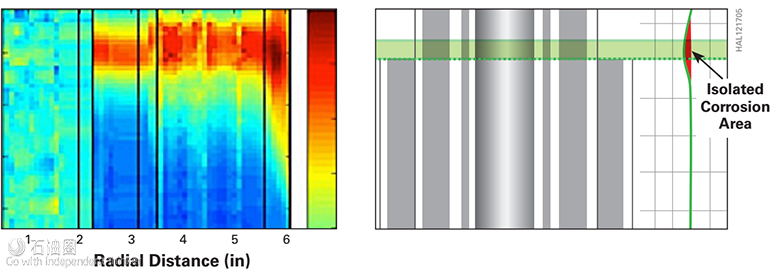Electromagnetic Pipe Xaminer® V (EPX™V) Tool
The new Halliburton Electromagnetic Pipe Xaminer® V (EPX™V) pipe inspection tool quantifies metal loss in one to five concentric strings of pipe in a wellbore using accurate High-Definition Frequency (HDF) technology. This capability enables customers to examine the whole well in one trip and assess pipe condition quickly. This unmatched capability also enables customers to reduce diagnostic time and have comprehensive information for monitoring programs and determining the right solution for any nonconformity in their completion.
The EPX V tool has an outside diameter of 111⁄16 in. and operates by inducing HDF electromagnetic energy into the surrounding pipe, which propagates through the concentric well strings with no wellbore fluid influences. The interaction with the metal of the pipe returns signals to the tool, yielding information on the metal loss present in the tubulars.
The magnitude and location of corrosion-induced defects are identified by the use of HDF variance algorithms of the returning electromagnetic waves. This information leads to a quick total-thickness calculation determining the overall condition of the pipe structure. Information on each string is also in the HDF signal, providing the state on metal loss in each pipe.
The EPX V tool operates off mono-conductor wireline or in memory mode on slickline, enabling more efficient wellsite operations through the use of cased-hole or slickline service equipment. This benefit also enables rigless intervention and conveyance flexibility to address multiple well construction and operational challenges.
Additionally, the EPX V tool is combinable with our other diagnostic services, such as the Acoustic Conformance Xaminer® (ACX™) tool, production logging, other corrosion inspection tools, pulsed-neutron logs, and bond logs. Halliburton used the EPX V tool after finding a well leak with the ACX tool as the customer needed to determine the extent of the repair job.
BENEFITS
» HDF technology provides accurate results
» Determines percent metal loss in one to five concentric pipes
» One-trip diagnostics, reduces operating costs
» Achieves fast results
» Operates in deviated or horizontal wells through multiple conveyance systems
FEATURES
» HDF technology
» Combinability
» Memory logging mode
» Temperature probe detects thermal variations
Case Study
Operator Identifies Shallow Surface-Casing Corrosion Without Costly Workover
OVERVIEW
An operator had a well experiencing an annulus B to annulus C pressure communication similar to others previously identified by the Halliburton Acoustic Conformance Xaminer® (ACX™) tool. Because of the leak, the well could not be produced. The operator wanted to determine the extent of the corrosion. Halliburton proposed assessing the corrosion using the Electromagnetic Pipe Xaminer® V (EPX™ V) tool, which indicated a shallow metal loss anomaly within a few feet of the surface-casing hanger. Additional subsequent surface diagnostics were performed, which indicated the anomaly’s shallow location. Since the problem was identified near surface, a rigless external casing repair could be performed, which will save the cost and avoid the risk associated with using a rig to cut and pull multiple strings of pipe.
CHALLENGES
Since the operator’s leak was impacting production, and similar wells in the area experience shallow surface-casing corrosion problems, the operator wished to know the extent of this potential problem to develop a remediation plan.
SOLUTIONS
Halliburton recommended assessing the corrosion using the new Electromagnetic Pipe Xaminer® V (EPX V) tool. The EPX V tool uses High-Definiton Frequency (HDF) technology, which is capable of logging the well in a single pass, without needing additional services to assign metal loss per pipe string. Additionally, the 1 11⁄16-in. OD allows for assessing the 9 5⁄8-in. surface casing from within the 2 7⁄8-in. tubing.
The EPX V tool operates off mono-conductor wireline or in memory mode, which allowed the operator flexibility in choosing how to run it most efficiently
RESULTS
The section of the well in question was logged, and the results indicated a shallow metal loss anomaly within a few feet of the surface-casing hanger. Subsequent surface diagnostics were performed, which indicated a shallow location. The operator cut windows into the conductor casing and positively verified the location and degree of the corrosion.
Since the leak was identified near surface, a rigless external casing repair was performed, saving the cost and avoiding the risk associated with using a rig to cut and pull multiple strings of pipe.
Looking forward in time, the operator plans to continue using the EPX V tool in an effort to survey and prioritize wells for additional proactive corrosion monitoring and prevention. Proactive
surveillance allows for optimized intervention timing and reduced well downtime. The EPX V and ACX diagnostic services can be run together, saving time and money, while providing a complete picture of the challenge.

 石油圈
石油圈

